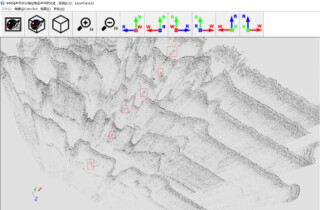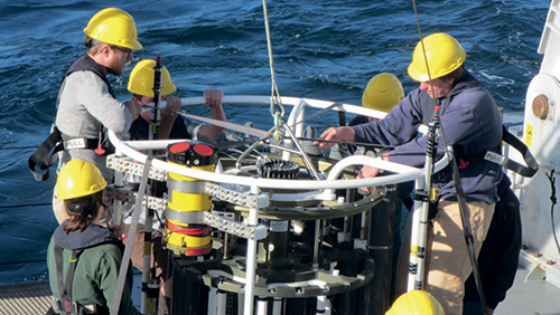

ADCPs Help to Reveal Trans-Tasman Pathway of Internal Tide
Surf’s up… down deep. The waters of the deep sea show layers with distinctive and persistent values of temperature and salinity. Scientists think that a dynamic balance maintains these steady values. Part of this balance is that heat must mix downward from the upper layers in order to warm cold deep waters from the poles. Questions about how and where this downward heat flux occurs are *hot* research topics. Teledyne RD Instruments Workhorse ADCPs play a vital role in helping to understand more about these topics in an attempt to answer some of these questions, specifically in Australia, operating in the Tasman Sea.
Teledyne Marine products deliver real-time data to assist scientists in identifying beam of deep sea energy
OVERVIEW
Surf’s up… down deep. The waters of the deep sea show layers with distinctive and persistent values of temperature and salinity. Scientists think that a dynamic balance maintains these steady values. Part of this balance is that heat must mix downward from the upper layers in order to warm cold deep waters from the poles. Questions about how and where this downward heat flux occurs are *hot* research topics.
Surf’s up… down deep. The waters of the deep sea show layers with distinctive and persistent values of temperature and salinity. Scientists think that a dynamic balance maintains these steady values. Part of this balance is that heat must mix downward from the upper layers in order to warm cold deep waters from the poles. Questions about how and where this downward heat flux occurs are *hot* research topics.

Internal tide pathway across the Tasman Sea (Credit: Luc Rainville, Harper Simmons, Dmitry Braznikov, Google Earth)
In 2015, an international team explored these ideas with coordinated expeditions funded by the National Science Foundation. They were called T-TIDE, T-BEAM, and T-SHELF. Around the (T)asman Sea, these scientists deployed many devices to explore sites where computer models showed a particularly energetic pathway. These internal waves come from tidal forcing at a ridge south of New Zealand. The scientists wanted to see the pathway of the waves and what happens when the waves hit the continental slope off Tasmania.
SITUATION
The subset of internal waves generated by tidal motions are the dark and silent type. Termed the internal tide, these waves heave the deep water up and down great distances; yet they show only slight excursions at the surface. They travel long distances underwater, yet little is known about their termination. En route, these internal waves exhibit strong currents. Ultimately, they shoal at the continental margins and break far below the surface.
In early 2015, scientists from several countries studied this type of internal wave in the Tasman Sea. One group searched for the pathway of the internal tide during its trans-oceanic passage. More specifically, they measured currents and water density through depth to discern the location, movement, and speed of the internal tide.
Among other tools, they relied on data from ship-mounted and lowered ADCPs (L-ADCP). For selecting their observational site, the scientists considered results from computer models and satellite altimeters. Working on the RV Falkor, they chose to run a transect that they thought would intersect the trans-oceanic pathway of the internal tide.

This display is a contour plat of currents seen with the ship-mounted ADCP. Red colors indicate stronger currents whereas yellow colors show weaker motions. The blue asterisk calls out a region with unusully high velocities. It was thought to be associated with the internal tide (Credit: Luc Rainville, Sam Kelly, Amy Waterhouse)
For finding the beam of wave energy, the scientists made repeated runs along a 200 km section for 30 hours. During six transects, they used shipboard ADCP measurements reaching 800 m depth. Their first goal was to identify the region of most energetic currents. Then, by repeating the section, they planned to reveal how the strength of the currents varied with time as well as location. In particular they were looking for a cycle of changing speed and direction that completed in 12.4 hours — period of the internal tide.
The need for this careful approach was to discern the currents of interest. Confounding the search were currents due to other sources. These included inertial waves radiating from recent stormy weather and strong eddies spawned by the East Australian Current.

Scientists prepare the hydrographic package to be lowered to the seabed. An upward looking ADCP, colored yellow to signify its high-pressure rating, is attached to the rosette, see front-left (Credit: Judy Lemus)
SOLUTION - LOWERED ADCP (L-ADCP)
For current profiling below the range of ship-mounted ADCPs, a creative solution was devised by Eric Firing in 1989. While concurrently measuring water properties, scientists worldwide lower compact ADCPs to the seabed. Careful processing corrects for the motions of the lowered package and the ship. Important contributions to both the L-ADCP method and processing came from Martin Visbeck and Andreas Thurnherr. (www.ldeo.columbia.edu/LADCP)
The ADCPs used in this manner are rated to operate at 6000 m depth. They are attached to a hydrographic package that is routinely lowered to catch water samples and to measure temperature and salinity. Sometimes dual ADCPs are used - looking up and down respectively. The package is lowered by a ship’s winch to the ocean floor.
During descent and ascent, the ADCP continues to measure current profiles with ranges to 100m. Later these short segments are stitched together to produce a full depth profile. When the L-ADCP approaches the seabed, the ADCP’s bottom tracking data is used in the processing.
Knowing the direction of the currents observed by the L-ADCP is essential for interpreting the record. A diligent compass calibration is needed to correct for magnetic interference due to the metal of the rosette that carries the hydrographic package.
These lowered ADCPs must endure great mechanical stress during hundreds of cycles going from air pressure to great depth.

From Visbeck (2002), this display depicts how ADCP profiles are stitched to form a full-depth profile (Visbeck, 2002: Deep Velocity Profiling Using Lowered Acoustic Doppler Current Profilers: Bottom Track and Inverse Solutions, J.Atm. Ocean. Tech., 19, 794-807)

The heading and tilt data recorded within the ADCP need to be calibrated before the ship sets sail (Credit: Judy Lemus)
RESULTS
Analyzing the sections of ship-mounted ADCP data, the team identified two salient features in the region of most energetic sub-surface currents. First the daily variation in the speed of the currents matched the periodicity of the presumed tidal forcing. Second, the direction of the currents aligned with the pathway predicted by computer models and observed with satellite altimetry.

Night operations recovering a CTD rosette that carries a L-ADCP (Credit: Amy Waterhouse)
Based on these findings, the scientists switched gears. While the ship held station, L-ADCP profiles were taken. The site for the first vertical slice was where water currents showed the most energy at depth — likely the center of the pathway. Over a 30-hour period, L-ADCP profiles were taken to 1700 m. The process was repeated at a second site farther north.
Ultimately, the team occupied nine L-ADCP sites that spanned the beam of the internal tide. They found the beam was directed to the northwest towards Tasmania and was about 200 km wide.
Do you have questions about this case study?
Get in touch with Teledyne Marine, and they would be happy to answer any questions you have about pricing, suitability, availability, specs, etc.


![3月21日-封面[1].jpg](https://cdn.geo-matching.com/voeE1ywo.jpg?w=320&s=6b3b1a0215d770f8797653e9202a8f52)




